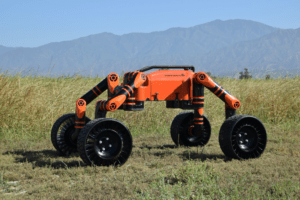BEDFORD, Mass. – Energid and Motiv announced today a software development kit that would allow users of Motiv’s RoboMantis modular robotic system to more easily program the robot.
The companies said Energid’s Actin SDK is a real-time adaptive robotic control tool kit that can help RoboMantis extend its capabilities within sophisticated applications in defense, industrial inspection, agriculture, mining, and academic research. The RoboMantis is a quadruped robot that can walk as well as use wheels for motion. With four legs and up to two 7-axis manipulators, the system offers up to 38 degrees of freedom, but the companies said exploiting the dexterity could pose “a daunting task for programmers.” For example, without Actin, developers of robotic systems needed to program intermediate waypoints to avoid collisions with the environment, and hand tune paths to avoid collisions, singularities, and joint limits.
“Actin automatically finds optimal paths in real time, responding to sensory input and then directing the robot on the most efficient path to avoid collisions,” said Doug Barker, COO at Energid. “For RoboMantis specifically, the Actin platform will take advantage of the hardware’s control and payload capabilities, with Actin’s constraint-based kinematics simplifying the programming to help facilitate applications that typically require a human – such as bomb retrieval, inspection, or material handling tasks within chemical plants or oil fields.”

RoboMantis is designed as a research platform and for multiple use cases. Source: Motiv Robotics
The Pasadena, Calif.-based Motiv originally licensed technology from the RoboSimian system, which was built for the 2015 DARPA Robotics Challenge by NASA’s Jet Propulsion Laboratory at the California Institute of Technology. The upgraded RoboMantis can carry gear, additional sensors, or mission-specific equipment. The mobile robot’s on-board computation with an advanced GPU enables rapid simultaneous localization and mapping (SLAM) operations of an unknown environment and the robot’s location within it, while affording template-based, semi-autonomous task execution.
“Part of having a robotic architecture that is modular and scalable is having options for customers that fit their specific needs,” said Motiv CEO Chris Thayer. “Enhancement options, such as the Actin add-on for the RoboMantis, will greatly expand our ability to meet our customers’ wide-ranging needs. We have been extremely impressed with Actin’s ability to control the RoboMantis platform.”
The platform’s software architecture will be based on Actin’s robot control framework (RCF), with robot programming done using Energid’s motion scripting interface, EcScript. The RCF architecture provides core modules for real-time robotic system controller development, and also enables developers to add custom transfer layers for inter-process communication and hardware integration.
In addition, the RCF’s configurable state machine architecture “enables the complex application logic necessary for high performance and safety of the robot hardware,” Energid said. The RoboMantis has two transfer layers – one for communicating with hardware, and the other for communicating with Robot Operating System (ROS) nodes. The system’s hardware control is based on EtherCAT, and the robot programming is enabled through an EcScript service provided by the ROS transfer layer.
More details on the system are available at this Energid blog post.